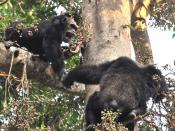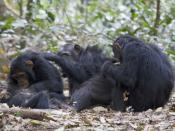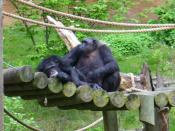The article entitled "Dim Forest, Bright Chimps" by Christophe Boesch and Hedwige Boesch-Anchermann (1991:72-75) shows that the use of crude tools and hunting strategies might have been the same between chimpanzees and our early ancestors. In 1979, a field team began a long-term study of the chimpanzees in the Tai National Park. The goal of studying these chimps was to help "shed new light on prevailing theories of human evolution" (72). Anthropologists believe that some 1.8 million years ago, hunting cooperatively and food sharing played an important role in developing our social system.
The first part of the article explains how the chimps use natural resources as tools. These tools include objects like branches, rocks, and heavy stones. These objects are used to crack open hard nuts, extract termites from their nests or even honey from a beehive. The chimps learn to use these tools with extreme precision, which make them more effective gatherers.
The field team focused mainly on the chimps cracking nuts. This was important to the field crew because no primate had ever been observed using rocks as hammers. By following the chimps' daily, the team found what tools the chimps were using and which kind of nuts they were eating. After examining the tools, the team found the tools to be very effective.
To prove this, the team would count how many strikes were required to crack a nut and the number of nuts that the chimp could open per minute. Some nuts proved to be more difficult to crack then others. This required the chimps to use different size rocks depending on the toughness of the nut. The stones and blocks that were found by the team ranged any where from ten ounces to 45 pounds. As the chimps moved from tree to tree,


